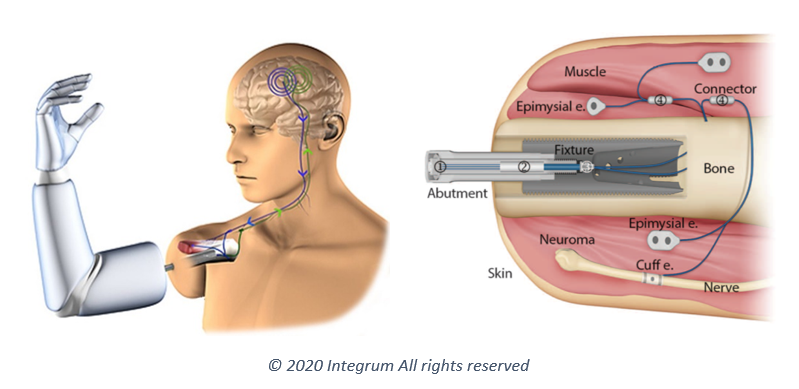In January 2013, Dr. Rickard Brånemark led the world’s first surgery where neuromuscular electrodes were permanently implanted in an amputee, connecting prostheses to the patient’s bone, nerves, and muscles. The e-OPRA™ Implant System remains in clinical trials today and is not commercially available.
The Next Generation Robotic Arm
Conventional robotic prostheses available today are attached with a socket and controlled via electrodes placed on the skin. Robotic prostheses can be very advanced, but such a control system makes them unreliable and limits their functionality, and patients commonly reject them as a result. By connecting the prosthesis directly to bone, nerves and muscles, the Integrum robotic system can provide a significantly improved user experience.
The e-OPRA™ Implant System remains in clinical trials today and is not commercially available.


Magnus – a Man Who Made History
Magnus, 42 years old from Haparanda in Northern Sweden, was the first patient in clinical trials to receive a prosthesis directly connected to bone, nerves, and muscles. Thanks to his new robotic arm, Magnus has been able to cope with all the situations he faces in his physically demanding job driving trailers in between Sweden, Norway, and Finland.
Read more about Magnus astonishing history:
English article: The Independent
Swedish article: SVT News
The e-OPRA™ Implant System remains in clinical trials today and is not commercially available.
How Does it Work?
The artificial arm is directly attached to the skeleton, thus providing mechanical stability. Then the human’s biological control system, that is nerves and muscles, is also interfaced via neuromuscular electrodes to the prosthesis via the advanced control system. This creates an intimate union between the body and the prosthesis; between biology and mechatronics.
The stack connector interfaced with a pin connector extending from the central sealing component, from which leads extended intramedullary and then transcortically to a final connector located in the soft tissue. The leads from the neuromuscular electrodes are mated to connector.

This connector is electrically linked to a second feed through connector embedded in the screw’s proximal end. The stack connector interfaced with a pin connector extending from the central sealing component, from which leads extended intramedullary and then transcortically to a final connector located in the soft tissue. The leads from the neuromuscular electrodes are mated to connector.

The e-OPRA™ Implant System remains in clinical trials today and is not commercially available.
